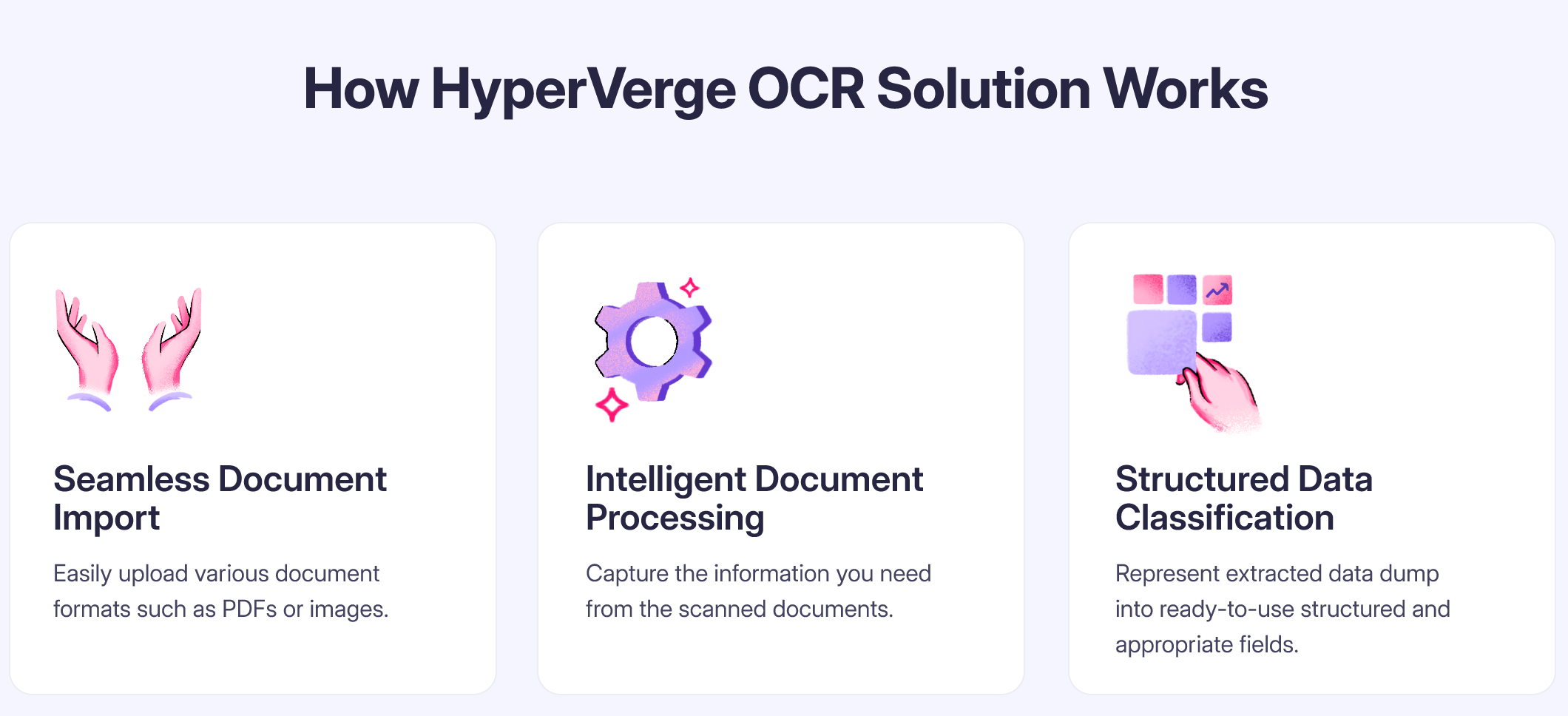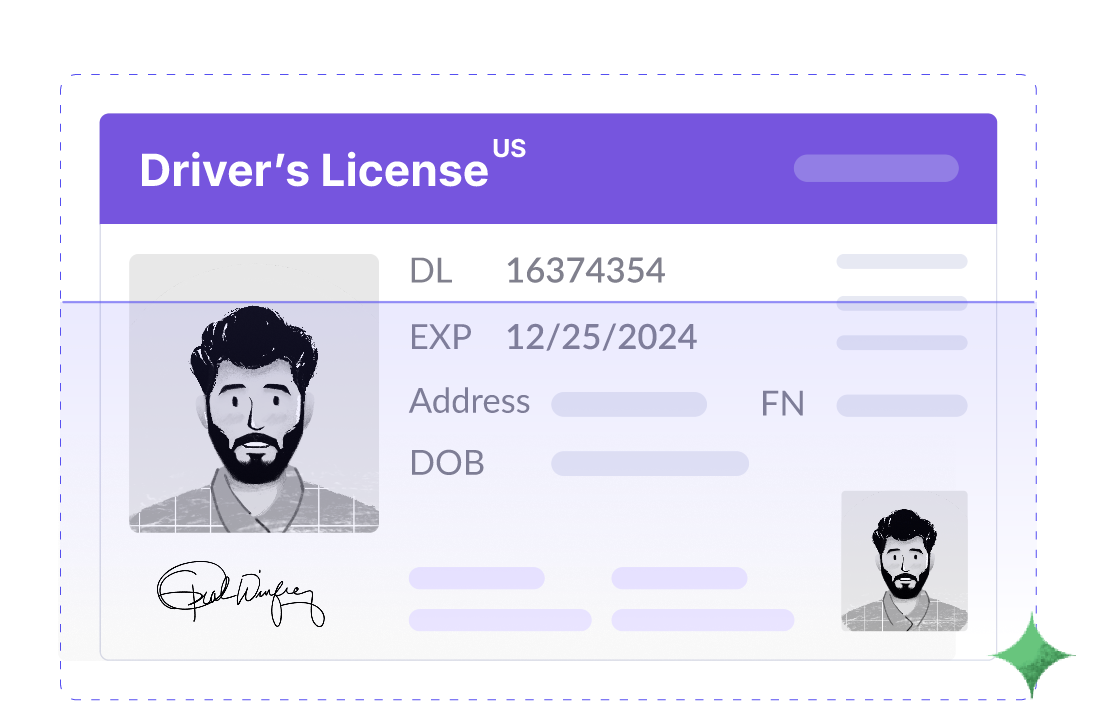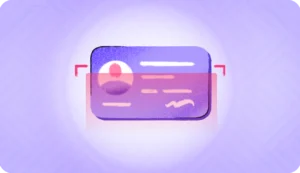Identification cards play a crucial role in validating our personal information and identity. Verifying ID cards is a vital step in the user onboarding process for the financial services industry, or any sector that needs to onboard authenticated users.
This is where you can employ ID OCR (Identity Document Optical Character Recognition) technology. This innovative technology automates and simplifies the process of extracting valuable information from identity documents, and other documents such as a passport or driver’s license. So, let’s look into how this amazing and transformative technology works.
What is optical character recognition (OCR)?
ID OCR (Optical Character Recognition) is a technology that enables recognizing and extracting text from digital data sources, images, or documents. Simply put, OCR tech is a software solution that can “read” the textual data from such digital documents and convert it into searchable and editable plain text.
Related Reads:
- What is Intelligent Document Processing (IDP)
- OCR vs ICR: What’s the Difference?
OCR for ID card has been employed across various industries for quite some time now. The rapid advancements in machine learning (ML) and artificial intelligence (AI) have improved the accuracy and efficiency of ID OCR. Now, ID OCR can recognize text in multiple languages, different font styles and font sizes, and even human handwriting.
This process of recognizing and extracting data from digital documents (identity or otherwise) happens through an OCR engine. There are several steps in this process, with each step crucial to the output quality and accuracy.
Here is a look at how ID OCR technology works:
Scanning and image pre-processing
The first step is image scanning and pre-processing. In this step, the identity document is scanned using a device like an ocr ID scanner or a camera. This captured image is then pre-processed. This pre-processing involves correcting any distortions or imperfections that may be present in the image. This step is crucial as it determines the accuracy of the OCR software.
Text detection
After the image is pre-processed, the OCR solution uses advanced algorithms to scan, identify, and locate any textual data that may be present in the image. The ‘text detection’ step also involves separating the text data from any images or graphics in the document completely. The current modern OCR software uses AI for the text detection process. They are so capable that they can segment individual characters, even if they are handwritten or are in different font styles.
Character recognition
Now, once the text is located, the OCR software then analyzes each individual character. After that, it converts the character into a digital format like the ASCII code. AI plays an important role here by helping to analyze and recognize characters with a high degree of accuracy – even if they are distorted, skewed, or illegible.
Post-processing
Next, the OCR software moves to the post-processing stage. Here, it corrects any errors or discrepancies that may be present in the document. This includes spelling checking, grammar correction, and even consistent formatting.
Output
This is the final step of converting the extracted textual data into a simple text file or a database. This conversion allows the information to be accessed and edited easily. This makes it ideal for tasks like data entry and document management.

Applications for information extraction from identity document
Having understood the workings of ID OCR, it is important to understand its practical implications. Let us take a look at some of the real-world applications of data extraction using OCR software.
Onboarding users
Several businesses require their customers to provide ID papers during the onboarding process. As a manual task, it can be daunting and overwhelming. However, with ID OCR, businesses can quickly and accurately collect important information like the customer’s name, age, and address directly from their documents. This advancement greatly assists in making the onboarding process much quicker and more effective.
Border control and security
Passport OCR is a vital tool for border control authorities and security agencies for countries across the world. It enables them to scan and verify the information on passports quickly and accurately. This helps ensure the authenticity of incoming travelers and prevents document fraud.
KYC compliance
Know-Your-Customer (KYC) regulations make it mandatory for financial institutions to conduct due diligence on their customers. OCR ID card technology can help in this verification process. It can extract relevant information from the customer’s identity documents and create a database. This makes it easier for such institutions to comply with regulatory requirements.
Healthcare
ID OCR can be used to extract patient information from identification documents. It can help reduce the time and error rates associated with the manual patient registration process.
Law enforcement
Law enforcement agencies like police departments can use ID OCR to identify an individual from their identity documents. This can help them in investigations and preventing identity theft.
Read more about OCR automation.
Advantages of using OCR technology for identity verification
ID OCR technology, when used for identity verification particularly, offers significant benefits over manual data entry and extraction. Here are some of the noteworthy benefits of using ID OCR:
- Increased Efficiency: OCR dramatically shortens the time required to extract information from identity documents. This is super beneficial in scenarios where large number of identity documents need to be processed. For example, banks and hospitals.
- Improved Accuracy: ID OCR scanning reduces the risk of human error associated with manual counterpart. This ensures that all the information extracted is accurate and reliable to the highest degree.
- Cost-Effective: Over a period of time, OCR solution can provide substantial cost savings – minimizing the need for manual labor and financial losses occurred to due data extraction and entry errors.
- Enhanced Security: OCR can help enhance data security by ensuring accurate document verification quickly. This makes it easier to detect document forgery and digital identity fraud cases.
- Regulatory Compliance: Lastly, using OCR for identity verification can help organizations comply with legal regulatory requirements, such as KYC and AML (anti-money laundering) regulations.
Types of identity document OCR and their challenges
There are numerous types of identity documents used worldwide, each with distinct characteristics that may pose unique challenges for OCR technology.
OCR for drivers license
These are commonly used ID documents that frequently have complex backgrounds and holography, which can make ID card OCR extraction more difficult. Varying layouts and different formats based on the issuing state or country can also complicate driver’s license OCR’s task.
Read more: How to verify a driver’s license

OCR for passports
As a globally-recognized document for identification, passports have a machine readable zone (MRZ). This machine readable text is easier for OCR engines to read and extract data from identity cards. That being said, passports also feature robust security measures like watermarks and holograms which can pose challenges to OCR.
Read more about passport verification here.
OCR for other ID documents
These documents range from national ID cards and birth certificates to social security cards and employee cards and more. The extensive use of ID cards and their varied designs – for example, different text layouts and security features – make them a challenge for ID card OCR technology.
Choosing the right optical character recognition (OCR) software
The kind and amount of identity documents that you are working with will determine which Optical Character Recognition (OCR) software you will need.
To illustrate, let’s say your business deals with a considerable amount of various identity documents (say hundreds or even thousands of passports, social security cards, driver’s licenses, and so on). In this scenario, you’ll require an OCR system that has the capability to handle a wide range of data inputs without compromising on both speed and accuracy.
For example, if your business processes several bank statements, you need an OCR solution that processes bank statements and extracts data to ensure precise and efficient data extraction.
Another critical factor to keep in mind when choosing OCR software is its accuracy. High accuracy results in less manual intervention and correction, improving process efficiency. The speed of extracting data from documents can also impact business operations. This is particularly critical in organizations and industries where real-time verification is needed.
In this age of increasing fraud risks, it is crucial to take privacy compliance into account. The OCR software you select must comply with strict data privacy regulations. In addition, it should have robust security measures in place to safeguard sensitive information.
Having the ability to integrate with your existing systems can greatly simplify your business operations as well as minimize any interruptions. It is important to make sure that the OCR solution you opt for can effortlessly merge with your current workflow and technological setup. This not only helps in saving time and resources but also simplifies the learning curve for your team.
Lastly, regular updates are essential to maintain compatibility with evolving document formats and recognition technologies. The chosen OCR software should be adaptable and continuously updated, staying in line with the latest advancements in the field.
Read more: Buyer’s Guide to Choosing the Best OCR software
Conclusion
OCR has emerged as a revolutionary tool for ID document processing and data extraction. It not only helps boost productivity but also guarantees data accuracy. This minimizes the need for manual intervention. That said, a complete, customizable ID verification software is what truly stands out when balancing the speed, accuracy, and compliance capabilities of OCR software.
HyperVerge‘s AI-powered OCR model has been honed over 13 years, with robust document verification. Our end-to-end identity verification solution offers robustness and scalability.
Sign up with HyperVerge today and try efficient ID OCR for yourself.






